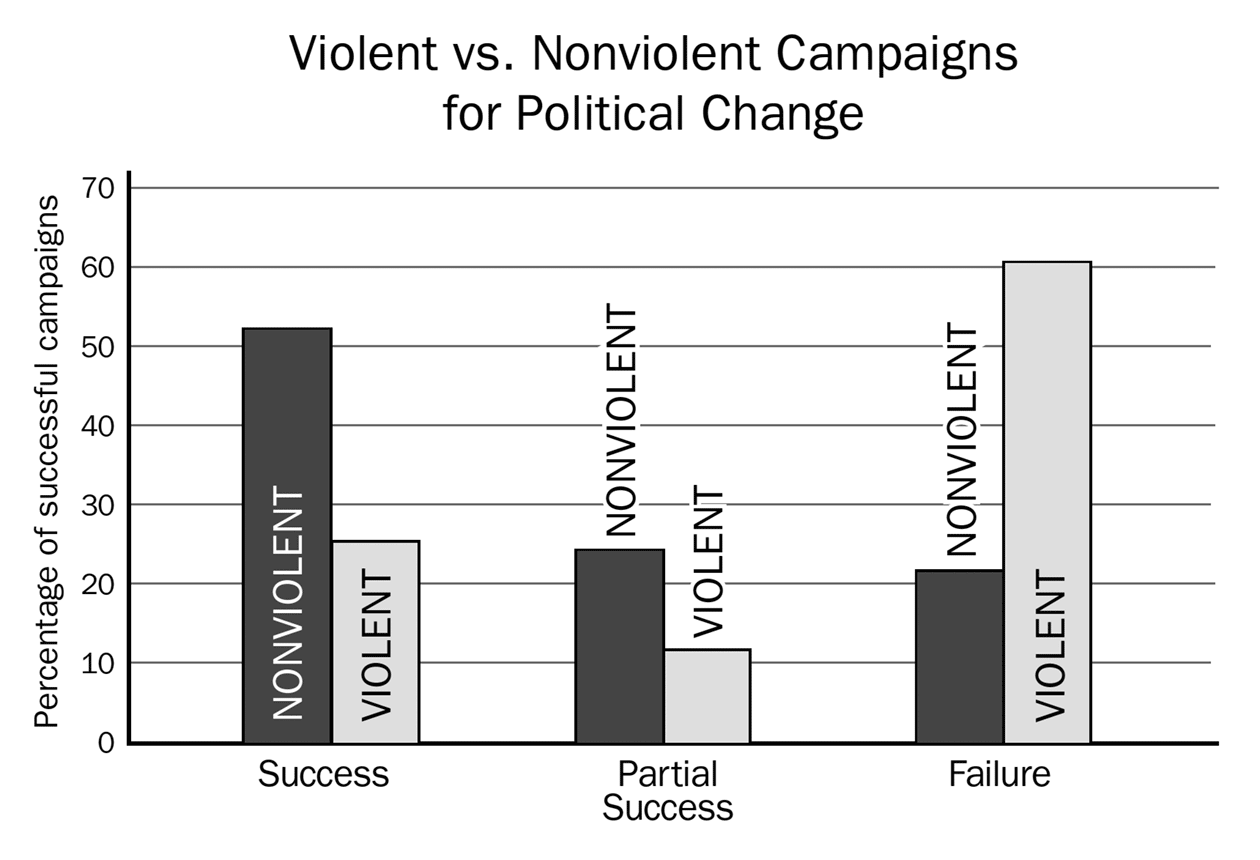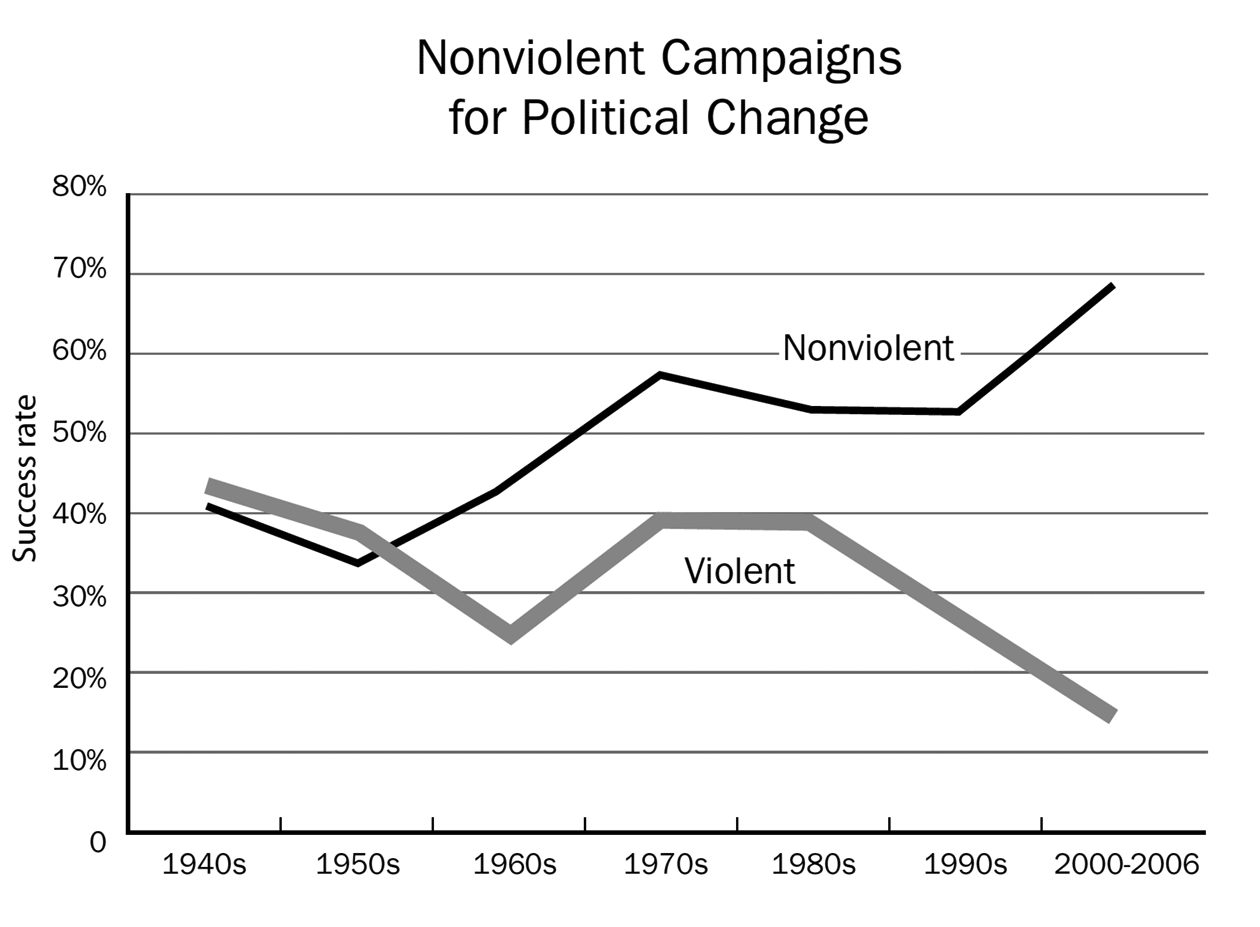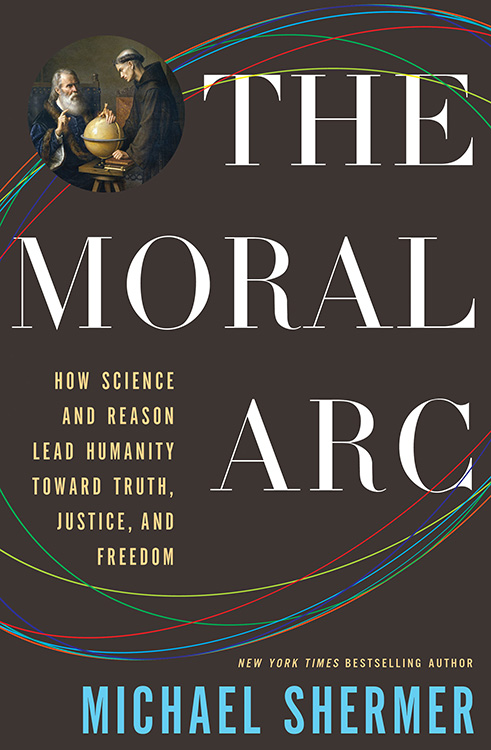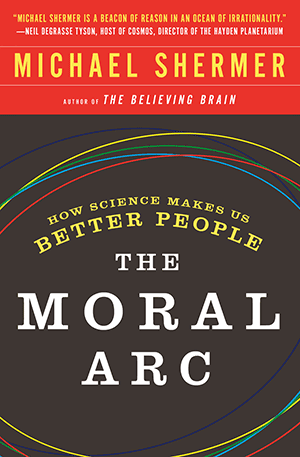Terrorism is not an Existential Threat
This article was originally published in Free Inquiry magazine Vol. 36, No. 6. in September 2016.
“We’re fortunate to be living in the most peaceful, most prosperous, most progressive era in human history,” President Barack Obama told an audience in Hannover, Germany on Monday April 25, 2016, in conjunction with also announcing that he was sending 250 more American special operations forces to Syria because of the terrorists activities ongoing in that war-torn country. “If you had to choose a moment in time to be born, any time in human history, and you didn’t know ahead of time what nationality you were or what gender or what your economic status might be, you’d choose today.”1 Obama went on to recount what a number of us have been saying for years about the long term progress of humanity (see, for example, Steven Pinker’s magisterial The Better Angels of Our Nature2 and my own The Moral Arc3), noting “that it’s been decades since the last war between major powers. More people live in democracies. We’re wealthier and healthier and better educated, with a global economy that has lifted up more than a billion people from extreme poverty.”
Such optimism is heartening, coming as it does from someone whose in-box is undoubtedly sagging from a daily barrage of bad news that he and his cabinet are tasked to deal. Although he clearly erred in calling ISIS a “JV team”, his military responses thus far have been commensurate with the actual threat that ISIS—or any other terrorist organization—poses.
What is an Existential Threat?
You hear the phrase “existential threat” a lot these days. A Google Ngram search shows that it didn’t come into use until the late 1950s, most likely in describing the growing threat of global thermonuclear war, crawls along the bottom of the curve through the 1960s, 1970s, and early 1980s. Then, around 1983, its use takes off in a steady upward trend line to 2001, after which it spikes dramatically upward in a hockey-stick like increase, clearly in response to 9/11 (see Figure 1).

Figure 1. Google Ngram search for the phrase “existential threat” 1950–2008.
What does existential mean when modifying a threat? Its derivation from the French philosophy of existentialism, which deals with existence—most notably the deepest and most meaningful aspects of human existence—implies a threat to our very existence as a civilization or species. Users of the phrase imply that if ISIS, for example, were successful in their global jihad to bring about Sharia law it would mean the end of Western civilization, and possibly the extermination of all who do not succumb and convert.
If ISIS or any of the other terrorist organizations grounded in Islamism were successful, I would agree that it would be an existential crisis. But are they, in fact, likely to succeed? No. I will demonstrate why below, but first I want to acknowledge that even if ISIS isn’t an existential threat, this doesn’t mean that they are not a threat of some sort.
Who is Existentially Threatening Us?
As most people know, it has become politically incorrect to associate “Islam” or “Muslims” with terrorism, out of fear that such an affiliation could lead to indiscriminate bigotry against the entire religion of Islam and against all Muslims. Thus was born the pejorative descriptor “Islamophobia,” applied to anyone who associates terrorism with the religion. Maajid Nawaz is a case in point. A former Islamist radical jailed for his activities, Maajid is now an Islamic reformer who artfully tries to strike the right causal balance, as in this Facebook post:
One cannot say ISIL are “Islam”, just like one cannot say they have nothing to do with Islam. They have something to do with it. When we refer to Stalin, we don’t disassociate him entirely from Communism though Trotsky hated what Stalin did and paid with his life. Naming ideologies is a crucial first step in being able to refute them. Islam is a religion. Islamism is the desire to impose Islam over society. Jihadism is the use of force to spread Islamism. It is this desire to impose Islam, i.e., Islamism, that we must refute.4
Semantic precision is a core component to science. To that end, the historian and publisher of Middle East Quarterly, Daniel Pipes, articulates the difference between Islam and Islamism:
Islamism is an ideology that demands man’s complete adherence to the sacred law of Islam and rejects as much as possible outside influence, with some exceptions (such as access to military and medical technology). It is imbued with a deep antagonism towards non-Muslims and has a particular hostility towards the West. It amounts to an effort to turn Islam, a religion and civilization, into an ideology.
Pipes notes that the word “Islamism” is appropriate here because it centers it as an ideology, not unlike fascism. “Islamism turns the bits and pieces within Islam that deal with politics, economics, and military affairs into a sustained and systematic program.” A program to do what? “Islamism offers a way of approaching and controlling state power. It openly relies on state power for coercive purposes.” As such, Pipes concludes:
Islamism is, in other words, yet another twentieth-century radical utopian scheme. Like Marxism-Leninism or fascism, it offers a way to control the state, run society, and remake the human being. It is an Islamic-flavored version of totalitarianism.5
Again, I will concede the point that if an Islamist organization did manage to grab the controls of state power and sweep across the world with arms and armies conquering countries, like Hitler or Stalin, then we would be facing an existential crisis. But the evidence leads me to conclude that nothing like this is in the offing.
Reasons Why We Need Not Fear Terrorism
Terrorism is a form of asymmetrical warfare by non-state actors against state actors and their innocent noncombatant civilians. It does so, as its name suggests, by evoking terror, which naturally arouses our moral emotions of revenge and justice. This, in turn, confounds clear thinking about terrorism. As such, it is good to review what we really know about terrorism, which has now been the subject of considerable social science research. Here are five reasons why I do not think terrorism poses an existential threat.
1. Terrorists are not pure evil. President George W. Bush was wrong when he said that the 9/11 terrorists hate us for “our freedom of religion, our freedom of speech, our freedom to vote and assemble and disagree with each other.”6 “Evil” may be a good adjective for describing something or someone you really don’t like but it only clouds our understanding of human behavior. Everyone has a motive and a point of view, including people we call evil. In a study of 52 cases of Islamic extremists who have targeted the U.S., for instance, the political scientist John Mueller concluded that terrorist motives are multivariate in nature and include instrumental violence and revenge: “a simmering, and more commonly boiling, outrage at U.S. foreign policy—the wars in Iraq and Afghanistan, in particular, and the country’s support for Israel in the Palestinian conflict.” Ideology in the form of religion, “was a part of the consideration for most,” Mueller continues, “but not because they wished to spread Sharia law or to establish caliphates (few of the culprits would be able to spell either word). Rather they wanted to protect their co-religionists against what was commonly seen to be a concentrated war upon them in the Middle East by the U.S. government.”7
There are practical motives as well, as the anthropologist Scott Atran has documented. Suicide bombers and their families, for example, are showered with status and honor and most “belong to loose, homegrown networks of family and friends who die not just for a cause, but for each other.” Most terrorists are in their late teens or early 20s, especially students and immigrants “who are especially prone to movements that promise a meaningful cause, camaraderie, adventure, and glory.”8
2. Terrorists are not that organized. Politicians like to portray terrorists as part of a vast global network of top-down centrally-controlled conspiracies against the West. But as Atran shows, terrorism is “a decentralized, self-organizing, and constantly evolving complex of social networks,” often organized through social groups and sports organizations, such as soccer clubs.9
3. Terrorists are not diabolical geniuses. The 9/11 Commission report described Al Qaeda terrorists as “sophisticated, patient, disciplined, and lethal.”10 But according to the political scientist Max Abrahms, after the decapitation of the leadership of the top terrorist organizations, “terrorists targeting the American homeland have been neither sophisticated nor masterminds, but incompetent fools.”11 Examples include: The 2001 airplane shoe bomber Richard Reid was unable to ignite the fuse because it was wet from the rain and his own foot perspiration; the 2009 underwear bomber Umar Farouk Abdulmutallab succeeded only in setting his pants ablaze, burning his genitals, and getting himself arrested; the 2010 Times Square bomber Faisal Shahzad managed merely to torch the inside of his 1993 Nissan Pathfinder; and the 2013 Boston marathon bombers were equipped with only one gun for defense and had no money and no exit strategy beyond hijacking a car with no gas in it that Dzhokhar Tsarnaev used to run over his brother Tamerlan, followed by a failed suicide attempt inside a land-based boat.
4. Terrorism does not cause mass deaths. In comparison to homicides in America, deaths from terrorism are in the statistical noise, barely a blip on a graph compared to the 13,700 homicides a year. By comparison, after the 3,000 deaths on 9/11, the total number of people killed by terrorists in the 38 years before totals 340, and the number killed after 9/11 and including the Boston bombing is 33, and that includes the 13 soldiers killed in the Fort Hood massacre by Nidal Hasan in 2009.12 That’s a total of 373 killed, or 7.8 per year. Even if we include the 3,000 people who perished on 9/11 and the 14 killed in San Bernardino, that brings the average annual total to 70.4, compared to that of the annual homicide rate of 13,700.
5. Terrorism doesn’t work. In a study of 42 foreign terrorist organizations active for several decades, Max Abrahms concluded that only two achieved their stated goals—Hezbollah achieved control over southern Lebanon in 1984 and 2000, and the Tamil Tigers took over parts of Sri Lanka in 1990, which they then lost in 2009. That results in a success rate of less than five percent.13 In a subsequent study, Abrahms and his colleague Matthew Gottfried found that when terrorists kill civilians or take captives it significantly lowers the likelihood of bargaining success with states, because violence begets violence and public sentiments turn against the perpetrators of violence. Further, they found that when terrorists did get what they want it is more likely to be money or the release of political prisoners, not political objectives.14 Finally, in terms of the overall effectiveness of terrorism as a means to an end, in an analysis of 457 terrorist campaigns since 1968 the political scientist Audrey Cronin found that not one terrorism group had conquered a state and that a full 94 percent had failed to gain even one of their strategic political goals. And the number of terrorist groups who accomplished all of their objectives? Zero. Cronin’s book is entitled How Terrorism Ends. It ends swiftly (groups survive only 5–9 years on average) and badly (the death of its leaders).15
Violent vs. Nonviolent Political Change
Terrorism is a form of violent political change. The political scientists Erica Chenoweth and Maria Stephan have documented the relative success and failure of violent vs. nonviolent campaigns for political change since 1900.16 Results: “From 1900 to 2006, nonviolent campaigns worldwide were twice as likely to succeed outright as violent insurgencies.” Chenoweth added that “this trend has been increasing over time—in the last 50 years civil resistance has become increasingly frequent and effective, whereas violent insurgencies have become increasingly rare and unsuccessful. This is true even in extremely repressive, authoritarian conditions where we might expect nonviolent resistance to fail.” Campaigns that relied solely on nonviolent methods were on average four times larger than the average violent campaign. And they were often much more representative in terms of gender, age, race, political party, class, and urban-rural distinctions.”17
How does this nonviolent strategy translate into political change? If your movement is based on violence, you are necessarily going to be limiting yourself to mostly young, strong, violence-prone males who have a propensity for boozing and brawling, whereas, Chenoweth explains, “Civil resistance allows people of all different levels of physical ability to participate—including the elderly, people with disabilities, women, children, and virtually anyone else who wants to.”18
Finally, nonviolent campaigns of political change are far more likely to result in democratic institutions than are violent insurgencies. “The data are clear,” Chenoweth concludes: “When people rely on civil resistance, their size grows. And when large numbers of people withdraw their cooperation from an oppressive system, the odds are ever in their favor.”19 Figures 2 and 3 show these remarkable trends.

Figure 2. Success rate of campaigns for political change since the 1940s comparing violent and nonviolent methods reveals that violence is a failed strategy and nonviolence is the method of choice.20

Figure 3. The percentage of successful campaigns for political change comparing violent and nonviolent methods.21
What About Nuclear Terrorism?
Osama bin Laden said he wanted to use nukes if he could get them, and Homeland Security Secretary Tom Ridge pressed the point in calling for more support for his agency: “Weapons of mass destruction, including those containing chemical, biological or radiological agents or materials, cannot be discounted.”22 But as Michael Levi of the Council on Foreign Relations reminds us, “Politicians love to scare the wits out of people, and nothing suits that purpose better than talking about nuclear terrorism. From President Bush warning in 2002 that the ‘smoking gun’ might be a mushroom cloud, to John Kerry in 2004 conjuring ‘shadowy figures’ with a ‘finger on the nuclear button’ and Mitt Romney invoking the specter of ‘radical nuclear jihad’ last spring, the pattern is impossible to miss.”23
But most experts agree that acquiring the necessary materials and knowledge for building either weapon is far beyond the reach of most (if not all) terrorists. In his book On Nuclear Terrorism, Levi invokes what he calls “Murphy’s Law of Nuclear Terrorism: What can go wrong might go wrong,” and recounts numerous failed terrorist attacks due to sheer incompetence on the part of the terrorists to build and detonate even the simplest of chemical weapons.24
In this context it is important to note that no dirty bomb has ever been successfully deployed resulting in casualties by anyone anywhere, and that according to the U.S. Nuclear Regulatory Commission—which tracks fissile materials—“most reports of lost or stolen material involve small or short-lived radioactive sources that are not useful for a RDD [radiological disbursal device, or dirty bomb]. Past experience suggests there has not been a pattern of collecting such sources for the purpose of assembling a RDD. It is important to note that the radioactivity of the combined total of all unrecovered sources over the past 5 years would not reach the threshold for one high-risk radioactive source.”25
In short, the chances of terrorists successfully building and launching a nuclear device of any sort is so low that we would be far better off investing our limited resources in diffusing the problem of terrorism in other areas.
As President Obama noted in his Hannover speech, such optimism “may surprise young people who are watching TV or looking at your phones and it seems like only bad news comes through every day.” It is a testimony to Obama’s intelligence and foresight to follow the trend lines instead of the headlines in assessing whether or not terrorism poses an existential threat to our civilization. It doesn’t.
References
-
Quoted in: Chasmar, Jessica. 2016. “Obama: We’re living in ‘most peaceful’ era in human history.” Washington Times, April 26. http://bit.ly/1VWTDfi
-
Pinker, Steven. 2011. The Better Angels of Our Nature. New York: Viking.
-
Shermer, Michael. 2015. The Moral Arc. New York: Henry Holt.
-
Nawaz, Maajid. 2015. Facebook Page Post. February 18. http://bit.ly/1VVKSmj
-
Pipes, Daniel. 1998. “Distinguishing Between Islam and Islamism.” Middle East Forum. June 30. http://bit.ly/WEZhXI
-
Quoted in: Perez-Rivas, Manuel. 2001. “Bush Vows to Rid the World of ‘Evil-Doers’.” CNN Washington Bureau. September 16. http://goo.gl/zrZMCV
-
Mueller, John and Mark G. Stewart. 2013. “Hapless, Disorganized, and Irrational.” Slate, April 22. http://goo.gl/j0cqUl
-
Atran, Scott. April 22. “Black and White and Red All Over.” Foreign Policy, April 22. http://goo.gl/SyhiEu
-
Ibid.
-
The 9/11 Commission Report, 2004. xvi. http://www.9-11commission.gov/report/911Report.pdf
-
Abrahms, Max. 2013. “Bottom of the Barrel.” Foreign Policy, April 24. http://goo.gl/hj4J1h
-
Bailey, Ronald. 2011. “How Scared of Terrorism Should You Be?” Reason, September 6. http://goo.gl/3ZvkR
-
Abrahms, Max. 2006. “Why Terrorism Does Not Work.” International Security, 31, 42–78. http://ow.ly/ttvYv
-
Abrahms, Max and Matthew S. Gottfried. 2014 “Does Terrorism Pay? An Empirical Analysis.” Terrorism and Political Violence.
-
Cronin, Audrey. 2011. How Terrorism Ends: Understanding the Decline and Demise of Terrorist Campaigns. Princeton: Princeton University Press.
-
Stephan, Maria J. and Erica Chenoweth. 2008. “Why Civil Resistance Works: The Strategic Logic of Nonviolent Conflict.” International Security, Vol. 33, No. 1, 7–44. See also: Chenoweth, Erica and Maria J. Stephan. 2011. Why Civil Resistance Works: The Strategic Logic of Nonviolent Conflict. Columbia University Press.
-
Stephan and Chenoweth, 2008.
-
Chenoweth, Erica. 2013. “Nonviolent Resistance.” TEDx Boulder. http://goo.gl/xqTy5P
-
Ibid.
-
Graph rendered from data in Stephan and Chenoweth, 2008, op cit., Chenoweth and Stephan, 2011, op cit., and Chenoweth, 2013, op cit.
-
Ibid.
-
Quoted in: Levi, Michael S. 2003. “Panic More Dangerous than WMD.” Chicago Tribune, May 26.
-
Levi, Michael S. 2011. “Fear and the Nuclear Terror Threat.” USA Today, March 24, 9A.
-
Levi, Michael S. 2009. On Nuclear Terrorism. Cambridge, MA: Harvard University Press, 5.
-
2012. “Fact Sheet on Dirty Bombs.” United States Nuclear Regulatory Commission, December. https://www.nrc.gov/reading-rm/doc-collections/fact-sheets/fs-dirty-bombs.html See also: http://www.policyalmanac.org/world/archive/dirty_bombs.shtml







